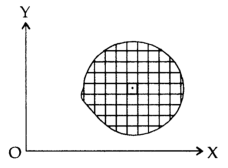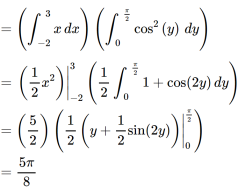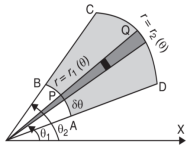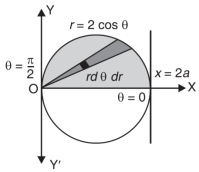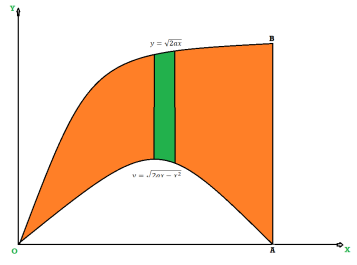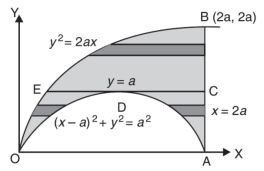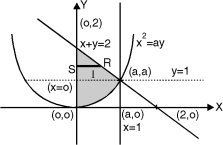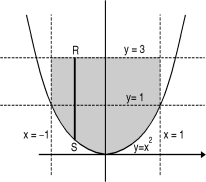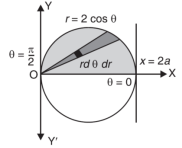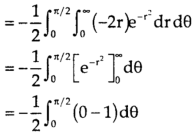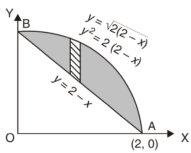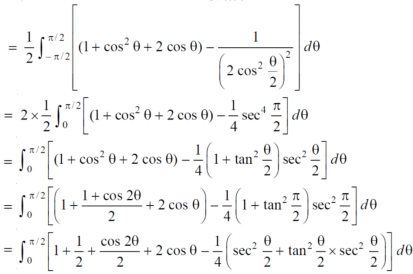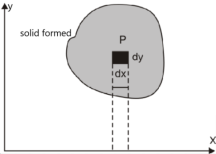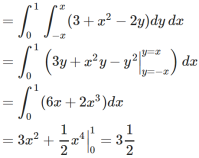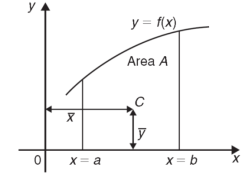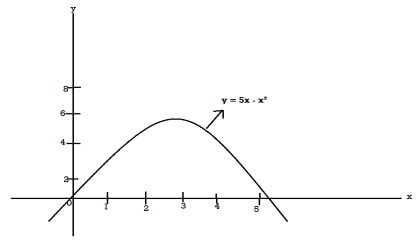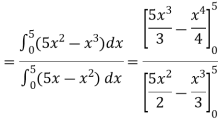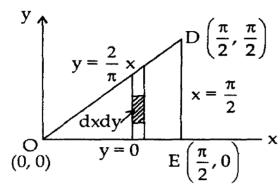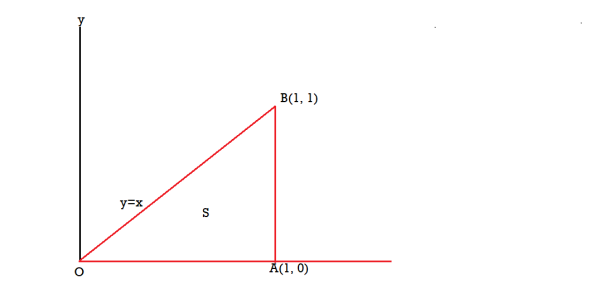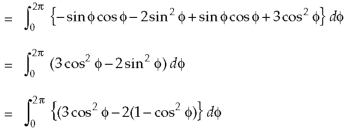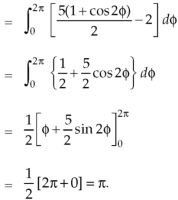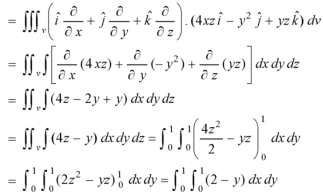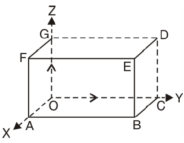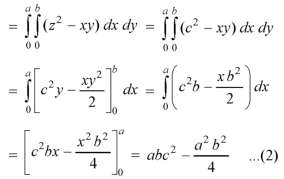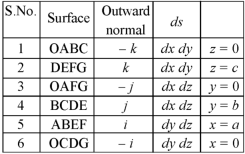UNIT-3
Multivariable calculus-Integration
Double integral – Before studying about multiple integrals , first let’s go through the definition of definition of definite integrals for function of single variable. As we know, the integral
Where is belongs to the limit a ≤ x ≤ b
This integral can be written as follows-
Now suppose we have a function f(x , y) of two variables x and y in two dimensional finite region Rin xy-plane. Then the double integration over region R can be evaluated by two successive integration
Evaluation of double integrals- If A is described as Then,
Let do some examples to understand more about double integration-
Example-: Evaluate
Sol. Let , I = = = = = 84 sq. unit. Which is the required area,
Example-2: Evaluate
Sol. Let us suppose the integral is I, I = Put c = 1 – x in I, we get I = Suppose, y = ct Then dy = c now we get, I = I = I = I = I = As we know that by beta function,
Which gives,
Now put the value of c, we get
Example-3: Evaluate the following double integral,
Sol. Let, I = On solving the integral, we get
Double integration in polar coordination - In polar coordinates, we need to evaluate
Over the region bounded by θ1 and θ2. And the curves r1(θ) and r2(θ)
Example-1: Evaluate the following by changing to polar coordinates,
Sol. In this problem, the limits for y are 0 to Suppose, y = squaring both sides, y² = 2x - x² x² + y² = 2x but in polar coordinates, we have, r² = 2r cosθ r = 2 cosθ
from the region of integration, r lies from 0 to 2 cosθ and θ varies from 0 to π / 2. As we know in case of polar coordinates, Replace x by r cosθ and y by r sinθ, dy dx by r drdθ, We get,
Example-2: Evaluate the following integral by converting into polar coordinates.
Sol. Here limits of y, y = y² = 2x - x² x² + y² = 2x x² + y² - 2x = 0 ………………(1)
Eq. (1) represent a circle whose radius is 1 and centre is ( 1, 0) Lower limit of y is zero. Region of integration in upper half circle, First we will covert into polar coordinates, By putting x by r cos θ and y by r sinθ , dy dx by r drdθ,
limits of r are 0 to 2 cosθ and limits of θ are from 0 to π / 2.
Example-3: Evaluate
Sol. Let the integral, I = =
Put x = sinθ
= π / 24 ans.
Triple integrals Definition: Let f(x,y,z) be a function which is continuous at every point of the finite region (Volume V) of three dimensional space. Divide the region V into n sub regions of respective volumes
is called triple integration of f(x, y, z) over the region V provided limit on R.H.S of above Equation exists.
Example-1: Evaluate
Solution: Let I = = (Assuming m = = = = = = = = I =
Example-2: Evaluate
Solution: It is convenient to transform the triple integral into spherical polar co-ordinate by putting
For the positive octant, r varies from r =b to r =a , I= = 8 =8 =8 =8 =8 log = 8 log I= 8 log I = 4 log Example-3: Evaluate
Solution:-
Ex.4: Evaluate-
Solution:-
|
Key takeaways-
Volume = 3. In Spherical polar system
4. In cylindrical polar system
|
The limits of integration change when we change the order of integration. We draw the rough diagram of the region of integration to find the new limits. Example-1: Change the order of integration in the double integral-
Sol. Limits are given- x = 0, x = 2a
And
and
The area of integration is the shaded portion of OAB. On changing the order of integration first we will integrate with respect to x, the area of integration has three portions BCE, ODE and ACD,
Now-
Which is the required answer.
Example: Change the order of integration in-
Sol. The limits are given as-
It means-
Also
Now we have here-
Example-2: Change the order of integration for the integral
Sol:
In the given integration, limits are
y = The region bounded by x2 = ay, x + y = 2a Fig.6.5
And x = 0, x = a is as shown in Fig. 6.5 Here we have to change order of Integration. Given the strip is vertical. Now take horizontal strip SR. To take total region, Divide region into two parts by taking line y = a. 1 st Region: Along strip, y constant and x varies from x = 0 to x = 2a – y. Slide strip IIelto x-axis therefore y varies from y = a to y = 2a. 2nd Region: Along strip, y constant and x varies from x = 0 to x= . Slide strip IIel to x-axis therefore x-varies from y = 0 to y = a. From Equation (1), (2) and (3), = = = (4a2 y – 4ay2 + y3) dy + y2dy = = = a4
Example-4: Express as single integral and evaluate dy dx + dy dx.
Given: I = dy dx + dy dx I = I1 + I2
The limits of region of integration I1 are The region of integration are as shown in Fig To consider the complete region take a vertical strip SR along the strip y varies from y to y = 3 and x varies from x = –1 to x = 1.
I =
|
Key takeaways-
2. |
Evaluation of double integrals in polar coordinates- Example: Evaluate-
Sol. Here we have-
Limits of y-
It represents the circle with centre (1, 0) and radius 1. Lower limit of y is 0. Region of integration is upper half circle. Lets convert the equation (1) into polar coordinates by putting- X = rcosθ and y = r cosθ
Limits of r are 0 to Limits of
Example: Evaluate-
By changing into polar coordinates. Sol. We have
The limits of x and y are 0 to Hence the region of integration is in the first quadrant,
The region is covered by the radius strip from r = 0 to r = ∞ and it starts from θ = 0 to θ = π/2 Hence the integral becomes-
|
Area of double integration Area in Cartesian coordinates- Example-1: Find the area enclosed by two curves using double integration. y = 2 – x and y² = 2 (2 – x) Sol. Let, y = 2 – x ………………..(1) and y² = 2 (2 – x) ………………..(2) on solving eq. (1) and (2) we get the intersection points (2,0) and (0,2) , we know that, Area =
Here we will find the area as below, Area =
Which gives, = ( - 4 + 4 /2 ) + 8 / 3 = 2 / 3.
Example-2: Find the area between the parabola y ² = 4ax and another parabola x² = 4ay.
Sol. Let, y² = 4ax ………………..(1) and x² = 4ay…………………..(2) then if we solve these equations , we get the values of points where these two curves intersect
x varies from y²/4a to now using the conceot of double integral, Area =
Area in polar coordinates- Example-3: Find the area lying inside the cardioid r = a(1+cosθ) and outside the circle r = a, by using double integration.
Sol. We have, r = a(1+cosθ) …………………….(1) and r = a ……………………………….(2) on solving these equations by eliminating r , we get a(1+cosθ) = a (1+cosθ) = 1 cosθ = 0 here a θ varies from – π/2 to π/2 limit of r will be a and 1+cosθ)
Which is the required area.
Example-4: Find the are lying inside a cardioid r = 1 + cosθ and outside the parabola r(1 + cosθ) = 1.
Sol. Let, r = 1 + cosθ ……………………..(1) r(1 + cosθ) = 1……………………..(2) solving these equations, we get (1 + cosθ )(1 + cosθ ) = 1 (1 + cosθ )² = 1 1 + cosθ = 1 cosθ = 0 θ = ±π / 2 so that, limits of r are, 1 + cosθ and 1 / 1 + cosθ The area can be founded as below,
Double integrals as volumes Suppose we have a curve y = f(x) is revolved about an axis , then a solid is generated , now we need to find out the volume of the solid generated ,
The formula for volume of the solid generated about x-axis,
Example-1: Calculate the volume generated by the revolution of a cardioid, r = a ( 1 – cosθ) about its axis
Sol. Here, r = a ( 1 – cosθ)
Volume =
=
which is the volume of generated by cardioid.
Example-2: Find the volume generated by revolving a circle x ² + y² = 4 about the line x= 3.
Sol. We know that, Volume = Here , PQ = 3 – x, =
The volume is 24π².
Example-3: Calculate the volume under the surface z = 3 + x² - 2y over the region R defined as 0≤ x ≤ 1 and -x ≤ y ≤ x
Sol. The is a double integral of z = 3 + x² - 2y over the region R. Volume will be,
CENTER OF MASS AND GRAVITY- Centre of mass- We have-
Mass = volume
Example: Find the mass of a plate formed by the coordinate planes and the plane-
The variable density
Sol. Here we the mass will be-
The limits of y are from y = 0 to y = b(1 – x/a) and limits of x are from 0 to a.
Therefore the required mass will be-
Which is the required answer.
Centre of gravity- The centre of gravity of a lamina is the point where it balances perfectly which means the lamina’s centre of mass. If
And
Example: Determine the coordinates of the centroid of the area lying between the curve y = 5x - x² and the x-axis. Sol. Here y = 5x - x²when y = 0, x = 0 or x = 5 Therefore the curve cuts the x-axis at 0 and 5 as in the figure-
Now
= 2.5
Therefore the centroid of the area lies at (2.5, 2.5) |
Key takeaways-
We have-
Mass = volume
|
Green’s theorem in a plane If C be a regular closed curve in the xy-plane and S is the region bounded by C then,
Where P and Q are the continuously differentiable functions inside and on C.
Green’s theorem in vector form-
Example-1: Apply Green’s theorem to evaluate
Sol. We know that by Green’s theorem-
And it it given that-
Now comparing the given integral- P = Now-
So that by Green’s theorem, we have the following integral-
Example-2: Evaluate Sol. First we will draw the figure-
Here the vertices of triangle OED are (0,0), ( Now by using Green’s theorem-
Here P = y – sinx, and Q =cosx So that-
Now-
= Which is the required answer.
Example-3: Verify green’s theorem in xy-plane for Sol. On comparing with green’s theorem, We get- P =
By using Green’s theorem-
And left hand side=
Now, Along
Along
Put these values in (2), we get- L.H.S. = 1 – 1 = 0 So that the Green’s theorem is verified.
Stoke’s theorem (without proofs) and their verification- If
Example-1: Verify stoke’s theorem when Sol. We know that by stoke’s theorem,
Here C is the unit circle-
So that-
Now again on the unit circle C, z = 0 dz = 0 Suppose, And Now
Now- Curl
Using spherical polar coordinates-
From equation (1) and (2), stoke’s theorem is verified.
Example-2: If
Sol. here we see that z-coordinates of each vertex of the triangle is zero, so that the triangle lies in the xy-plane and Now, Curl Curl
The equation of the line OB is y = x Now by stoke’s theorem,
Example-3: Verify Stoke’s theorem for the given function-
Where C is the unit circle in the xy-plane.
Sol. Suppose-
Here We know that unit circle in xy-plane- Or
So that,
Now Curl
Now,
Hence the Stoke’s theorem is verified.
Gauss divergence theorem If V is the volume bounded by a closed surface S and Then it can be written as-
where Example-1: Prove the following by using Gauss divergence theorem- 1. 2. Where S is any closed surface having volume V and
Sol. Here we have by Gauss divergence theorem-
Where V is the volume enclose by the surface S.
We know that-
= 3V 2. Because
Example – 2 Show that Sol By divergence theorem, Comparing this with the given problem let Hence, by (1)
Now ,
Hence,from (2), Weget,
Example Based on Gauss Divergence Theorem
Soln. We have Gauss Divergence Theorem By data, F=
=(n+3)
2 Prove that Soln. By Gauss Divergence Theorem,
|
Key takeaways-
2. Green’s theorem in vector form-
3. Stoke’s theorem
4. Gauss divergence theorem
|
Example: Evaluate-
Where
And S is the surface of the cube bounded by x = 0, x = 1, y = 1, z = 0, z = 1. Sol. By the Divergence theorem-
Example: By using divergence theorem to evaluate-
Where-
And S is the surface of the sphere Sol.
On putting x =
Example: Use the divergence theorem to evaluate-
Over the surface of a sphere of radius ‘a’. Sol. Here we have-
= 3 × Volume of the sphere
Example: Verify the Gauss divergence theorem for-
Taken over the rectangular parallelopiped
Sol. We have-
Volume integral-
To evaluate
Add 1,2,3,4,5 and 6, we get-
The Gauss divergence theorem is varified.
|
References
- E. Kreyszig, “Advanced Engineering Mathematics”, John Wiley & Sons, 2006.
- P. G. Hoel, S. C. Port And C. J. Stone, “Introduction To Probability Theory”, Universal Book Stall, 2003.
- S. Ross, “A First Course in Probability”, Pearson Education India, 2002.
- W. Feller, “An Introduction To Probability Theory and Its Applications”, Vol. 1, Wiley, 1968.
- N.P. Bali and M. Goyal, “A Text Book of Engineering Mathematics”, Laxmi Publications, 2010.
- B.S. Grewal, “Higher Engineering Mathematics”, Khanna Publishers, 2000.
- T. Veerarajan, “Engineering Mathematics”, Tata Mcgraw-Hill, New Delhi, 2010
- Higher engineering mathematics, HK Dass

